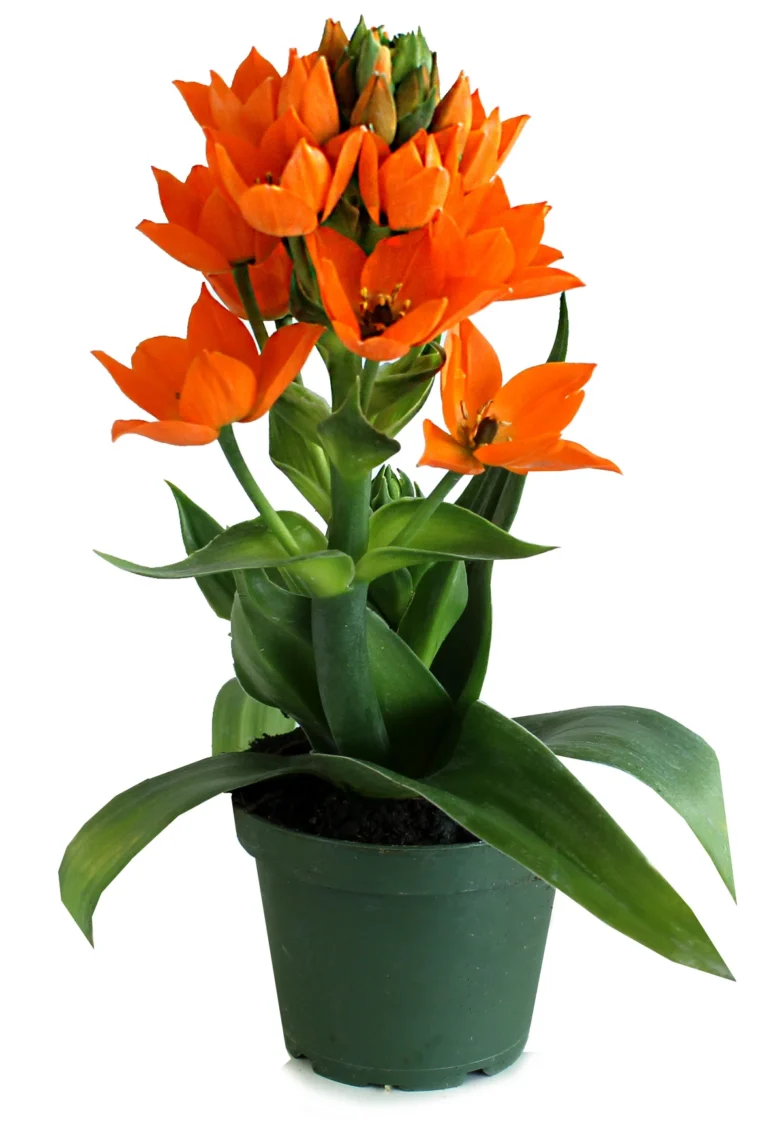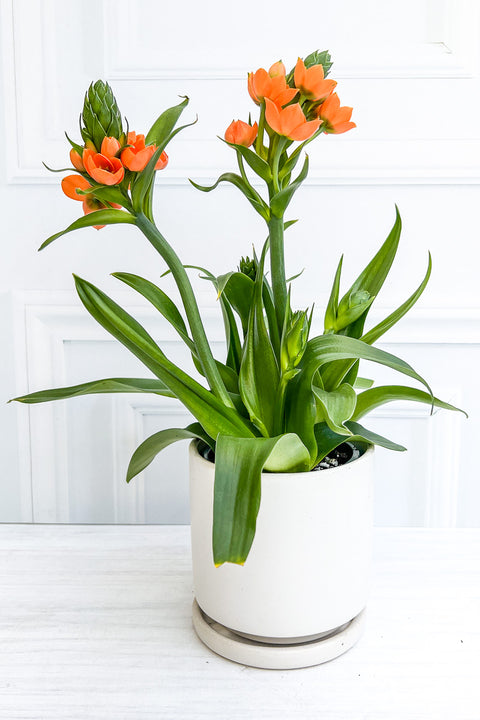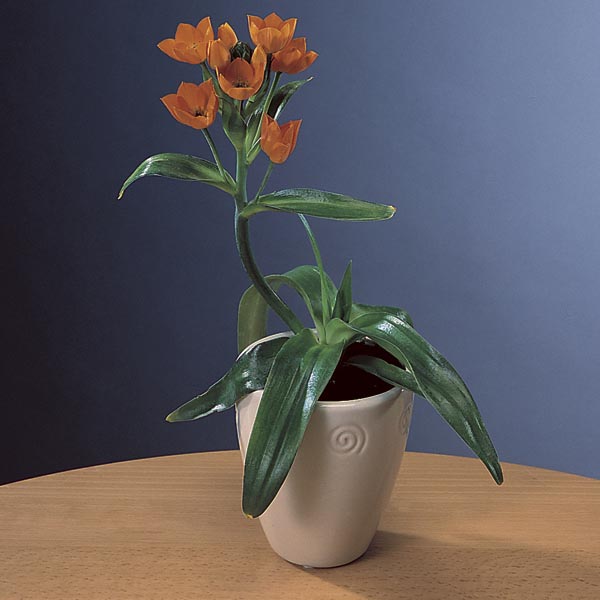As an Amazon Associate, I earn from qualifying purchases.
The Orange Star plant, also known as Ornithogalum dubium, can thrive both indoors and outdoors. It prefers bright, indirect light and well-drained soil.
The Orange Star plant is a vibrant, eye-catching addition to any garden or home. Its bright orange blooms provide a burst of color, making it a popular choice among gardeners and plant enthusiasts. This plant thrives in bright, indirect light and well-drained soil, which makes it versatile for both indoor and outdoor settings.
Indoors, it can be placed near a sunny window, while outdoors, it should be in a spot that receives partial sunlight. Regular watering is essential, but avoid overwatering to prevent root rot. The Orange Star plant is relatively low-maintenance, making it ideal for both novice and experienced gardeners.
Choosing The Right Location
The Orange Star Plant thrives in various environments. Choosing the right location is crucial for its growth. Below, we explore the best indoor spots and ideal outdoor conditions for your Orange Star Plant.
Best Indoor Spots
Finding the perfect indoor spot is vital. The Orange Star Plant loves sunlight. Place it near a south-facing window. This ensures it gets plenty of light. Avoid placing it in direct sunlight. The leaves can burn. Indirect light works best. A bright room with filtered light is ideal.
Humidity is also important. The plant enjoys moderate humidity. A humidifier can help. Bathrooms or kitchens often have higher humidity levels. These can be great spots too. Ensure the plant is not near drafts. Air conditioners or heaters can harm it.
Ideal Outdoor Conditions
Outdoors, the Orange Star Plant needs the right conditions. Plant it in a well-drained soil. Ensure it gets full sun to partial shade. Morning sun is best. Too much afternoon sun can be harsh. Protect it from strong winds.
Watering is crucial. The soil should be moist but not soggy. Overwatering can cause root rot. Mulch can help retain moisture. Fertilize during the growing season. This helps the plant bloom beautifully.
Below is a table summarizing the ideal conditions:
| Condition | Indoor | Outdoor |
|---|---|---|
| Light | Bright, indirect | Full sun to partial shade |
| Soil | Well-drained potting mix | Well-drained garden soil |
| Water | Keep soil moist | Moist, not soggy |
| Humidity | Moderate | Moderate |

Credit: www.homesandgardens.com
Soil Requirements
The Orange Star Plant, also known as Ornithogalum dubium, thrives both indoors and outdoors. Soil is crucial for its growth and health. Ensuring the right soil type and preparation will help your plant flourish.
Preferred Soil Type
The Orange Star Plant prefers well-draining soil. It needs soil that retains moisture but does not stay soggy. A mix of sandy loam and organic matter works best. You can use a standard potting mix with added sand. This ensures good aeration and drainage.
Soil Preparation Tips
Proper soil preparation is key to a healthy Orange Star Plant. Follow these steps to prepare the soil:
- Choose the right potting mix: Use a commercial potting mix with added sand or perlite.
- Add organic matter: Mix in compost or aged manure to enrich the soil.
- Ensure proper drainage: Make sure the pot or garden bed has drainage holes.
Here is a simple table showing the ideal soil mix:
| Component | Percentage |
|---|---|
| Sandy Loam | 60% |
| Organic Matter | 20% |
| Perlite | 20% |
Use these tips to ensure your plant grows strong and beautiful. Happy planting!
Watering Needs
The Orange Star Plant is a popular choice for both indoor and outdoor settings. Understanding its watering needs is essential for maintaining a healthy plant. Proper watering ensures vibrant blooms and robust growth. This section will guide you through the essential aspects of watering your Orange Star Plant.
How Much To Water
The Orange Star Plant requires consistent watering. It’s crucial to keep the soil moist but not soggy. Water the plant thoroughly until water drains from the bottom of the pot. Allow the top inch of soil to dry out before the next watering.
| Season | Watering Frequency |
|---|---|
| Spring | Every 5-7 days |
| Summer | Every 4-6 days |
| Fall | Every 7-10 days |
| Winter | Every 10-14 days |
Signs Of Overwatering
Overwatering can harm your Orange Star Plant. Look for these signs:
- Yellowing leaves
- Soft, mushy stems
- Root rot
- Mold on soil surface
To prevent overwatering, ensure the pot has good drainage. Always check the soil moisture before watering again. Adjust watering frequency based on your home’s humidity and temperature.
Lighting Conditions
The Orange Star Plant, also known as Ornithogalum dubium, is a vibrant addition to any garden or home. To thrive, it requires the right lighting conditions. This section will guide you through the ideal lighting scenarios for both indoor and outdoor settings.
Natural Light Needs
Orange Star Plants love bright, indirect sunlight. Place them near a window with filtered light. Direct sunlight can harm their leaves. Outdoors, choose a spot with morning sun and afternoon shade. Too much sun can scorch the plant.
- Bright, indirect sunlight
- Filtered light near a window
- Morning sun, afternoon shade outdoors
Artificial Lighting Options
If natural light is insufficient, artificial lighting can help. LED grow lights are an excellent choice. They should be placed 12 inches above the plant. Use a timer to provide 12-14 hours of light daily.
| Type of Light | Distance from Plant | Duration |
|---|---|---|
| LED Grow Lights | 12 inches | 12-14 hours |
- LED grow lights
- 12 inches above plant
- 12-14 hours of light daily
Fertilizing The Orange Star Plant
The Orange Star Plant, with its vibrant blooms, thrives with proper care. Fertilizing is key to ensuring healthy growth and abundant flowering. Here, we break down the best fertilizers and a fertilizing schedule for your Orange Star Plant.
Best Fertilizers
Choosing the right fertilizer is essential. The following fertilizers work best for the Orange Star Plant:
- Balanced Liquid Fertilizer: Use a 10-10-10 or 20-20-20 formulation. These provide equal parts nitrogen, phosphorus, and potassium.
- Slow-Release Granules: These release nutrients over time. They provide consistent nourishment.
- Organic Compost: Enhances soil texture and provides essential nutrients.
Fertilizing Schedule
Follow this simple schedule for fertilizing your Orange Star Plant:
- Spring: Start with a balanced liquid fertilizer every two weeks.
- Summer: Continue with the liquid fertilizer. Switch to slow-release granules once a month.
- Fall: Reduce fertilizing to once a month using organic compost.
- Winter: Stop fertilizing. Allow the plant to rest.
Ensure to water the plant before and after fertilizing. This prevents root burn and helps in nutrient absorption.
| Season | Fertilizer Type | Frequency |
|---|---|---|
| Spring | Balanced Liquid Fertilizer | Every Two Weeks |
| Summer | Slow-Release Granules | Once a Month |
| Fall | Organic Compost | Once a Month |
| Winter | None | None |
By following this schedule and using the recommended fertilizers, your Orange Star Plant will flourish indoors or outdoors. Happy gardening!

Credit: rocketfarms.com
Pruning And Maintenance
To keep your Orange Star Plant healthy, regular pruning and maintenance are essential. These practices ensure the plant remains vibrant and blooms beautifully, whether it is indoor or outdoor.
When To Prune
Pruning the Orange Star Plant at the right time is crucial. The best time is after the blooming period. This usually happens in late spring or early summer. During this time, remove any dead or damaged stems. This helps the plant focus its energy on new growth.
Maintenance Tips
Regular maintenance keeps your Orange Star Plant in top shape. Follow these tips for a thriving plant:
- Watering: Water the plant when the soil feels dry. Avoid overwatering.
- Fertilizing: Use a balanced fertilizer during the growing season.
- Light: Ensure the plant gets bright, indirect light. Direct sunlight can scorch the leaves.
- Pest Control: Check for pests regularly. Remove any pests you find promptly.
Here is a quick reference table for your Orange Star Plant maintenance:
| Task | Frequency |
|---|---|
| Pruning | After blooming period |
| Watering | When soil is dry |
| Fertilizing | During growing season |
| Light | Bright, indirect |
| Pest Control | Regular checks |
Maintaining your Orange Star Plant ensures it stays beautiful. Follow these simple tips for a thriving plant, whether it’s indoors or outdoors.
Common Pests And Diseases
The Orange Star Plant, whether grown indoors or outdoors, can attract pests and diseases. Keeping your plant healthy requires understanding these threats. Below, we explore common pests and diseases, how to identify them, and ways to treat and prevent these issues.
Identifying Pests
Common pests affecting the Orange Star Plant include aphids, spider mites, and mealybugs. These pests can weaken your plant and reduce its beauty.
| Pest | Signs of Infestation |
|---|---|
| Aphids | Yellowing leaves, sticky residue, and stunted growth |
| Spider Mites | Webbing on leaves, tiny yellow spots, and leaf drop |
| Mealybugs | White cottony masses, weak growth, and leaf yellowing |
Treatment And Prevention
To treat aphids, use a mixture of water and dish soap. Spray this solution on affected areas. Repeat weekly until the pests are gone.
For spider mites, increase humidity and wipe leaves with a damp cloth. In severe cases, use neem oil or insecticidal soap.
Mealybugs can be removed with a cotton swab dipped in alcohol. Gently dab the pests until they are removed.
Preventing pests involves regular inspection and maintaining plant health. Keep the plant’s environment clean and free from debris. Avoid overwatering, as it can attract pests and diseases.
- Inspect your plant weekly for early signs of pests.
- Maintain proper watering and sunlight levels.
- Use natural insecticides if needed.
Propagation Techniques
Propagation of the Orange Star Plant can be quite satisfying. This process allows you to expand your plant collection. With the right techniques, you can grow vibrant new plants.
Methods Of Propagation
The Orange Star Plant can be propagated in two main ways:
- Division: This is the most common method. Carefully separate the offsets from the parent plant.
- Seeds: Collect seeds from the spent flowers. Plant them in a suitable soil mix.
Both methods have their own benefits. Division is faster and more reliable. Seed propagation allows for genetic diversity.
Best Time To Propagate
The best time to propagate your Orange Star Plant is in early spring. At this time, the plant is emerging from dormancy. The warmer temperatures and increased light help new growth thrive.
For division, ensure the parent plant is healthy and strong. Use a sharp, clean tool to make the cut. Plant the divisions in well-draining soil.
For seed propagation, sow the seeds in a warm, bright location. Keep the soil moist but not waterlogged. Germination can take several weeks.
Ensure you provide the right conditions for successful propagation. This includes proper light, temperature, and moisture levels. Happy growing!
Seasonal Care Tips
The Orange Star Plant, known for its bright orange flowers, needs specific care through different seasons. Proper care ensures it thrives both indoors and outdoors. Follow these seasonal care tips to keep your Orange Star Plant healthy and vibrant.
Winter Care
During winter, the Orange Star Plant needs special attention. The plant goes dormant and requires less water. Overwatering can cause root rot. Maintain a cool indoor temperature, around 50-60°F (10-15°C).
- Watering: Water sparingly. Keep soil slightly moist but not wet.
- Light: Place it in a bright spot, but avoid direct sunlight.
- Humidity: Ensure moderate humidity. Avoid placing near heaters.
- Fertilizing: No need to fertilize during winter dormancy.
Summer Care
In summer, the Orange Star Plant becomes more active. It needs more water and sunlight to thrive. Proper care during this season helps it bloom beautifully.
- Watering: Water regularly. Keep soil consistently moist.
- Light: Place in a sunny location. Ensure at least 6 hours of sunlight.
- Fertilizing: Apply a balanced, water-soluble fertilizer every 4-6 weeks.
- Temperature: Maintain a warm environment, around 65-75°F (18-24°C).
| Care Aspect | Winter | Summer |
|---|---|---|
| Watering | Sparingly | Regularly |
| Light | Bright, indirect | Direct sunlight |
| Fertilizing | Not needed | Every 4-6 weeks |
| Temperature | 50-60°F (10-15°C) | 65-75°F (18-24°C) |

Credit: chaletnursery.com
Frequently Asked Questions
Can The Orange Star Plant Grow Indoors?
Yes, the Orange Star plant can grow indoors. It requires bright, indirect sunlight and well-draining soil. Regular watering is essential.
How Often Should I Water The Orange Star Plant?
Water the Orange Star plant when the top inch of soil is dry. Avoid overwatering to prevent root rot.
What Kind Of Light Does The Orange Star Plant Need?
The Orange Star plant needs bright, indirect sunlight. Direct sunlight can scorch its leaves, so avoid placing it in direct sun.
Is The Orange Star Plant Safe For Pets?
No, the Orange Star plant is toxic to pets. Keep it out of reach of cats and dogs.
Conclusion
Choosing the Orange Star Plant for your home or garden offers beauty and versatility. Its vibrant blooms thrive both indoors and outdoors. With proper care, this plant can brighten any space year-round. Consider adding the Orange Star Plant to your collection for a splash of color and charm.

